Winter Creeps In
By Maggie Streeter, Palmer Station correspondent
July 20, 2018

Photo Credit: Joshua Neff
The station celebrates midwinter with a feast on the solstice.
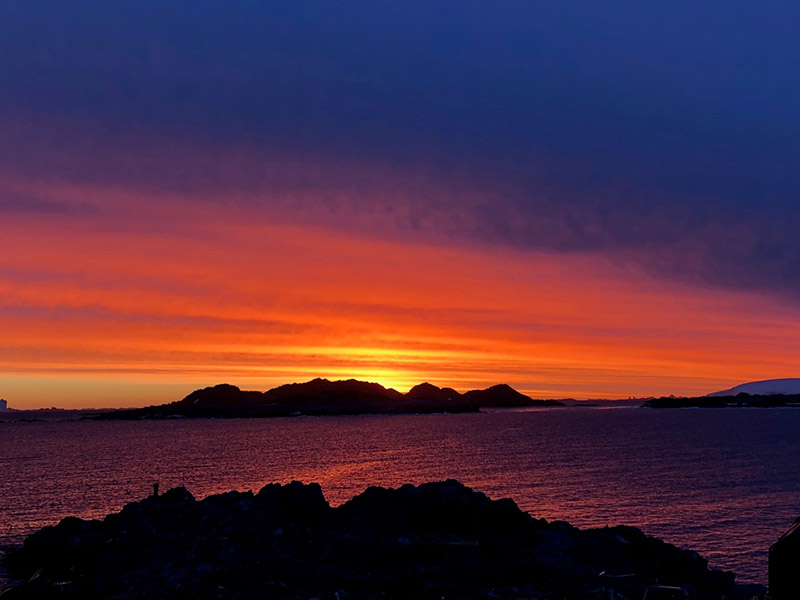
Photo Credit: Joshua Neff
Though never shrouded in 24-hour darkness, Palmer Station only sees about 3 hours of sunlight around midwinter.
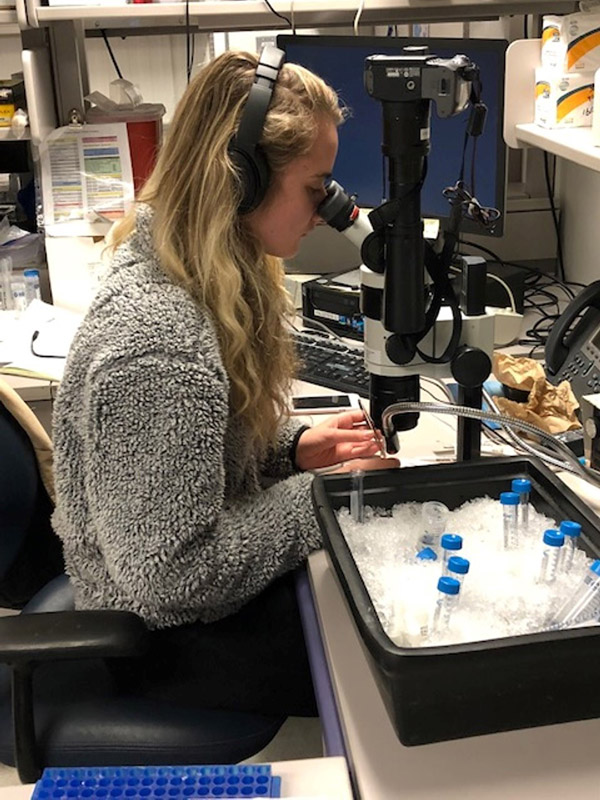
Photo Credit: Joshua Neff
Researcher Maggie Streeter studies fish embryos.
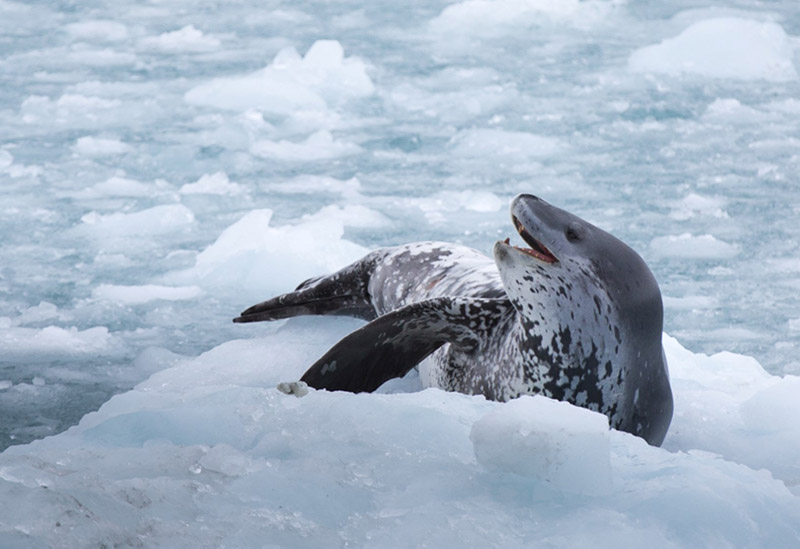
Photo Credit: Lisa Harding
A leopard seal reclines on an ice flow in Hero inlet.
It was a busy June for Palmer station, starting with the departure of the Laurence M. Gould. After a flurry of packing, consolidating and saying goodbyes, the ship sailed on June 15th, carrying half the station’s population with it. It was a bittersweet departure: we missed our friends, but we also all got to have our own rooms. Tradeoffs.
Thankfully, we got to celebrate with them before they left at the “Crosstown Dinner.” The crew of the LMG piled into the galley, dining with the summer and winter crews. It was a perfect way to send off the remaining summer crew, and our chef, Kristen, made some incredible food (as always). The next morning, the summer folks moved onto the ship, and the following morning the Gould set off, leaving the winter crews weeping in the wake. Well, only some of us were weeping (me, for one).
Much of June’s socializing seemed to center around food, as the next notable event was the Midwinter feast. Kristen crafted an amazing banquet that would put any mere “feast” to shame, featuring lobster, duck and the best cheesecake I’ve ever had. She made me believe in cheesecake again. Fun was had and all were sleepy and happy. The feast was thrown to celebrate the solstice, the official beginning of winter. The day was just over three hours long. Everyone on station was excited to experience longer days on the peninsula again, and we expect to see the sun rise higher over the glacier very soon.
Below the galley, the scientists have been scurrying around throughout June. The science team is caring for more than 200,000 quickly developing fish embryos. The embryos are critical to several ongoing projects off station and are sampled at predetermined developmental time-points. The end of June brought tiny heartbeats to the embryos, much earlier than expected. We were able to sample the embryos, with intensive scurrying and rushing. We’ve settled into our roles and are appreciating the lag in sampling days as the embryos mature.
Palmer is still surrounded by wildlife, even as winter ice creeps across the water. We’ve spotted leopard seals lying around on ice floes and some following the boats through the water. Leopard seals look like wolf-shark hybrids and are the only predator around Palmer that eats animals as large as humans. For this reason, we keep our distance from the slippery beasts, lest they decide to see how humans might taste. They’re very cute from afar!
Snow continues to fall and has finally blanketed the Piedmont glacier, allowing for more skiing and snowshoeing opportunities. Even as ice creeps up to the pier, interfering with usual boating, folks are finding fun increasingly in the backyard and on the glacier. Some of us hope that the ice will stay, but some hope the ice around the pier will clear, allowing for recreational boating to resume. Whichever group, we all love to watch the icebergs periodically freeze in around the edges of station or see the pancake ice turn the inlet into a veined crust. Maybe, by August, the bay will freeze, or maybe we’ll get to keep boating until summer arrives again. Either way, the people of Palmer have plenty to do and see off-station and within.
A Rainy 50th Anniversary at Palmer Station
By KC Loosemore, Palmer Station correspondent
April 16, 2018
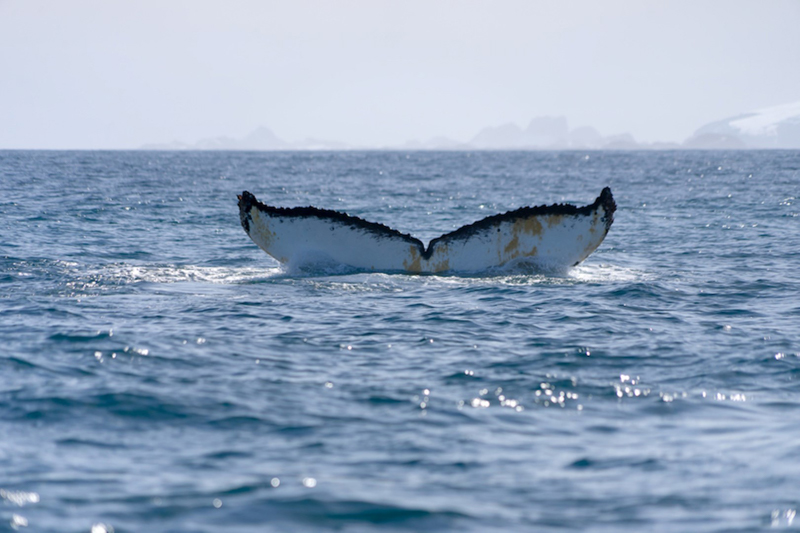
Photo Credit: KC Loosemore
Researchers identify whales, like this humpback whale spotted near Palmer Station, by the markings on their tails.
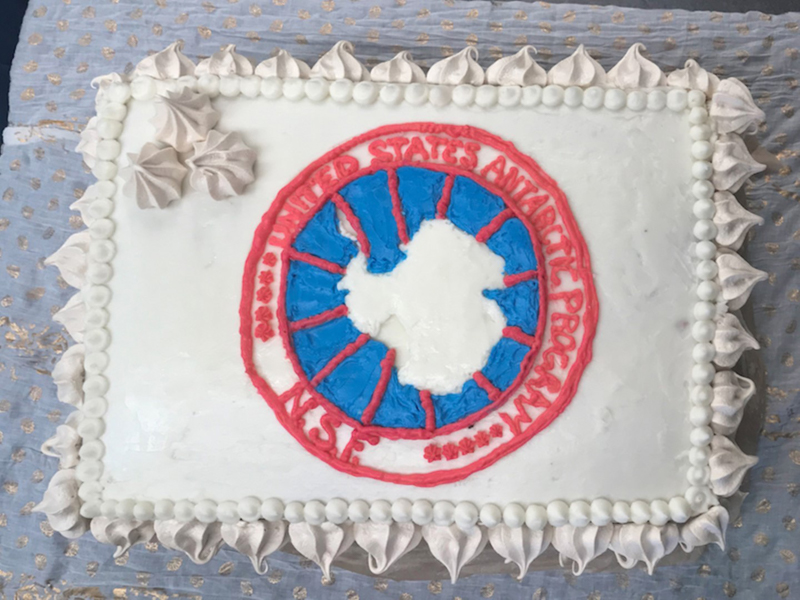
Photo Credit: KC Loosemore
Chef Mark Mican made a U.S. Antarctic Program-themed cake to celebrate Palmer Station's 50th anniversary.
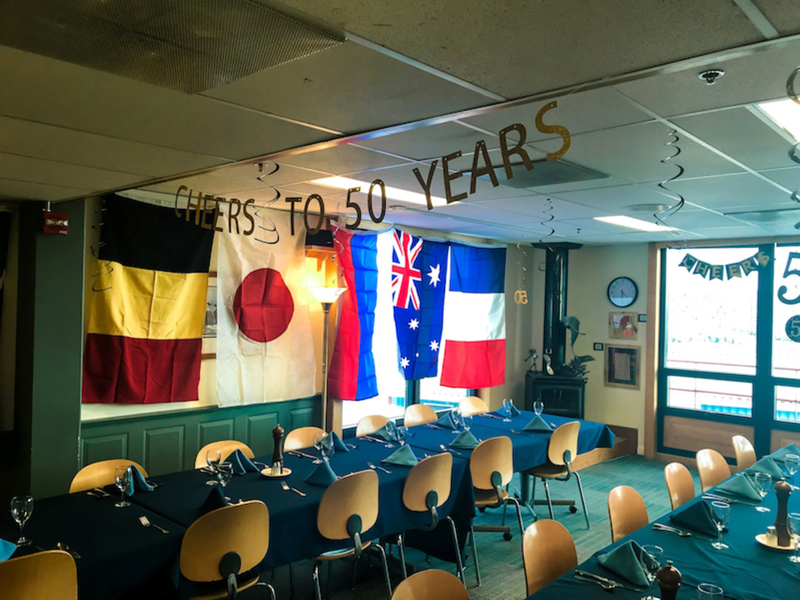
Photo Credit: KC Loosemore
Station residents decorated the Palmer Station galley to celebrate the 50th anniversary of the station being built.
The month of March was marked by an incredible number of storms and the amount of rain pour-ing down on the station. Massive gusts of wind, sometimes exceeding 50 knots, blew hard against our buildings. The frequent rain and precipitation made it hard for the scientists to get out on the water for sampling.
Though the rain seemed to never stop, the scientists and the support staff made sure that they were able to get the work done. There were a few occasions where they went out in weather that was initially within the safe-boating limits, only to be called back because the winds increased.
Though the station’s resident whale researchers were hard-pressed to make any sightings during the inclement weather, they did not stop trying to get out as much as possible. They constantly sat in their labs watching the weather reports waiting for the winds to die down just a few knots.
Early in the month, the whale-research cruise on board the R/V Laurence M. Gould concluded after collecting tissue samples from Minke and humpback whales. They also recorded some excit-ing videos of whale behavior from their deployable drones overhead.
The entire team from the Friedlaender whale group seemed very pleased upon their return to the station, which excited the entire community. The principal investigators were able to give the Palmer community a sneak peek into some of their findings during a fascinating science talk be-fore they left.
March also marked a special milestone for Palmer Station. The community put on their best clothes, decorated the galley, and celebrated Palmer Station’s 50th anniversary. The cooks made an elaborate dinner complete with a National Science Foundation cake baked by chef Mark Mi-can.
Station management and long-time employees gave speeches on how working at the station has affected their lives and how Palmer Station is continually pushing the boundaries of Antarctic research. They highlighted also how the early builders likely never saw how big this station would become and how important it would end up being for understanding Antarctica.
Chuck Amsler, a researcher involved in the study of chemical ecology of macroalgae, tracked down one of the construction workers who was with the original crew that built the foundation for Palmer Station. We called him on the phone and had a short conversation. It was fascinating to be able to talk to a member of the original crew.
Following the phone call, the station crew raised the flag and posed for a group photo. As the month of March comes to a close, the turnover boat for the summer crew arrived at station. The end of the month is busy with community members training the incoming staff for their various jobs. The new staff is the 2018 winter crew that will stay for the majority, if not all, of winter until the summer boat arrives to pick them up six months from now.
A New Year
By Leigh West, Palmer Station correspondent
February 5, 2018
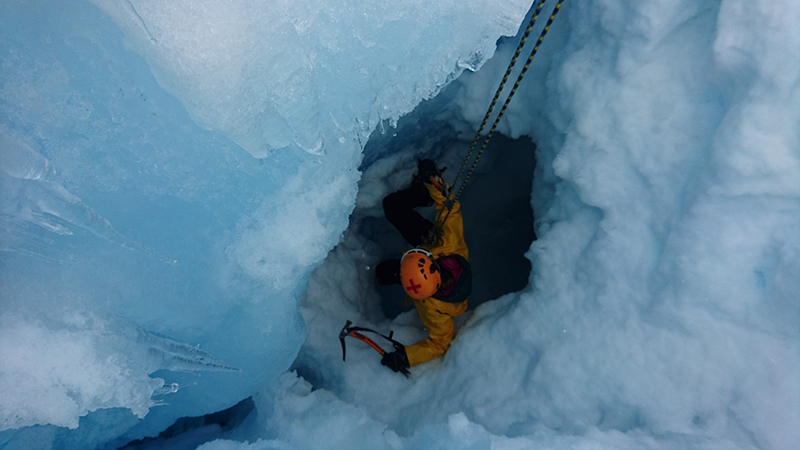
Photo Credit: Marissa Goerke
Ground search and rescue team member Carly Quisenberry prepares to climb out of a crevasse at a training for the emergency teams
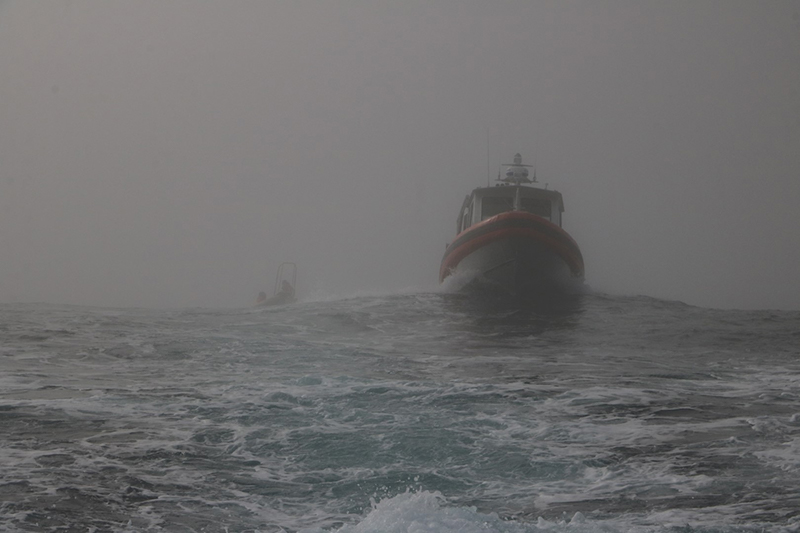
Photo Credit: JD Gantz
The seabird researchers attempt to reach the Rosenthal Islands through the fog on board the RHIB Rigil.
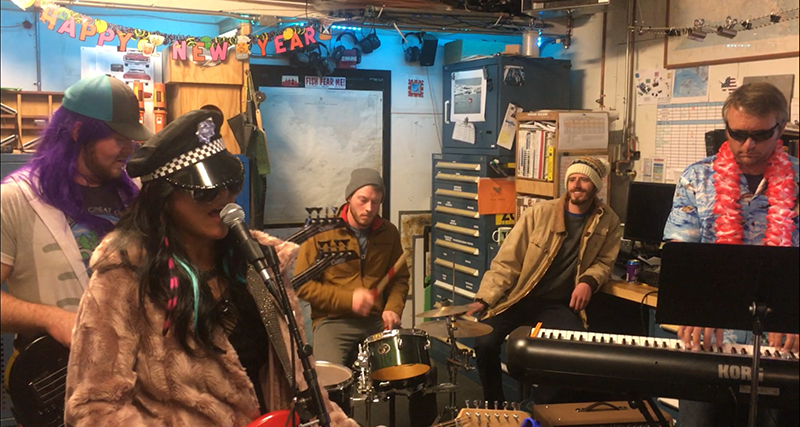
Photo Credit: Leigh West
Palmer's band plays for the community at a New Year's Eve party.
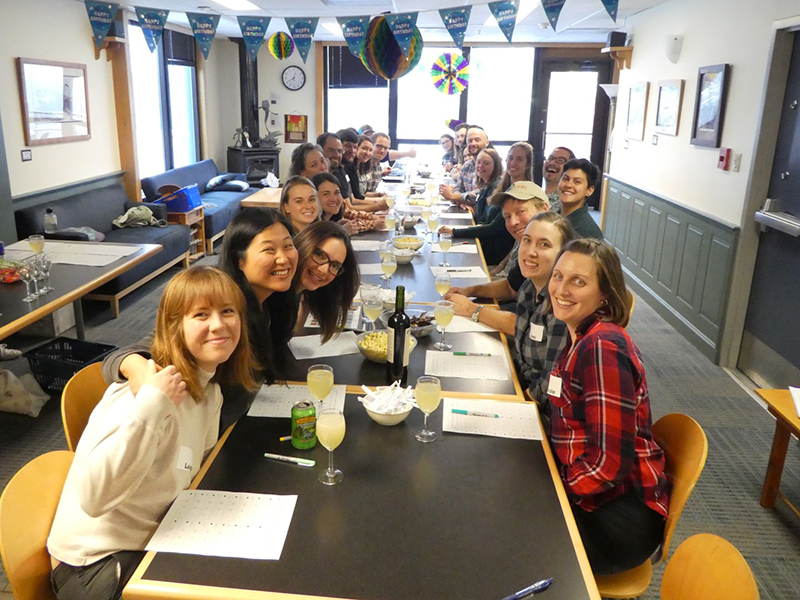
Photo Credit: Carly Quisenberry
Station members and LTER cruise socialize at a "Speed Friending" event held during the Research Vessel Laurence M. Gould’s most recent port call.
The New Year got off to a rocking start here at Palmer, with the community coming together for a party over the holiday weekend. We rang in 2018 with a performance from Palmer’s band, which played “covers” as well as a few original songs. Many other community members also contributed to the event, including the repurposing an old fishing float for a Times Square-style ball drop, complete with adornments like krill, diatom chains, penguins and glittery glaciers.
The first week of January brought the return of the Research Vessel Laurence M. Gould, ferrying several new Palmerites as well as a boat full of Long Term Ecological Research Project (LTER) scientists for their annual research cruise. As has become tradition, the LTER port call at Palmer was as entertaining as it was busy. Days were spent transporting science equipment and chemicals from station to ship, while nights were dedicated to hosting social events like crosstown dinner and the second-annual “Speed Friending” extravaganza.
The divers and the whale researchers were the two additions to station from this month’s boat, and both have been up to exciting work since their arrival. The divers have been completing an array of projects on the pier and boat ramp, only occasionally deterred by leopard seals. The two whale researchers, doctoral student Greg Larson and research technician Ross Nichols, have been hitting the water daily both searching for whales and running transects with an echo sounder to determine the abundance of krill in the area. Whenever they spot whales, they photograph them in order to identify individuals from their fluke patterns to see if the same whales are revisiting Palmer Station year after year. The whalers also take small biopsy samples in order to examine things like genetics and hormones in the animals, and next month will begin flying drones to further investigate Palmer’s whale and seal populations.
There have been some noteworthy boating operations this month as well. Mid-month, the station’s two new RHIBs made an attempt to reach the Rosenthals, a group of islands outside Palmer’s traditional boating limits. The islands are too far to reach via Zodiac alone, and the trip has always been made using the Gould. Though fog and wind prevented the party from landing on the Rosenthals on their first attempt, the buggers and birders hope to make it there soon. A few days before the end of January, a glider that was deployed last month encountered a shoal in the Joubins Islands and had to be rescued by Palmer personnel. Thankfully, it was recovered successfully, though looking a little worse for the wear.
January was an exciting month for emergency teams at Palmer as well. Since we have so few people on station at any given time, the support staff here must wear many hats. In addition to their ‘day’ jobs, each contract employee is a member of at least one emergency team and is trained how to respond to various potential crises that could arise. This month, there was a joint training for Ground Search and Rescue (GSAR), Ocean Search and Rescue (OSAR) and trauma. The three teams worked together to practice evacuating an injured person from Palmer via Twin Otter, driving them in a Zodiac from station to the base of the glacier and then carrying them to the top. A couple of weeks later, GSAR members simulated rescuing a victim who had fallen into a crevasse, with each member repelling down into the icy cavern before climbing their way back out. Not to be left out of the excitement, under the guidance of fire marshal Carly Quisenberry, the fire team also had a big drill this month. A room on station was smoked out using a fog machine and a victim had to be rescued in the reduced-visibility conditions. All of us at Palmer are very grateful for the hard work of our emergency team members who work very hard to make us feel safe at such an isolated research station.
A Month In Review
By Leigh West, Palmer Station correspondent
January 26, 2018
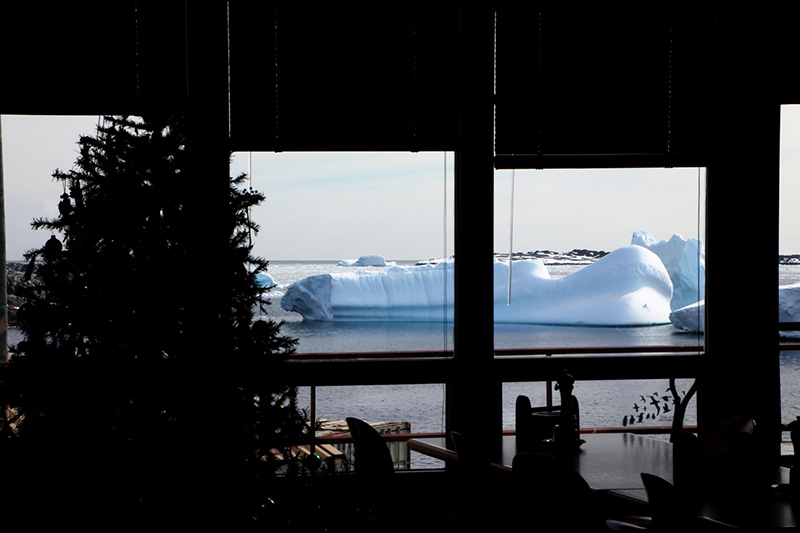
Photo Credit: Marissa Goerke
The view from the stations galley with a Christmas tree in the foreground as large icebergs pass by the harbor.
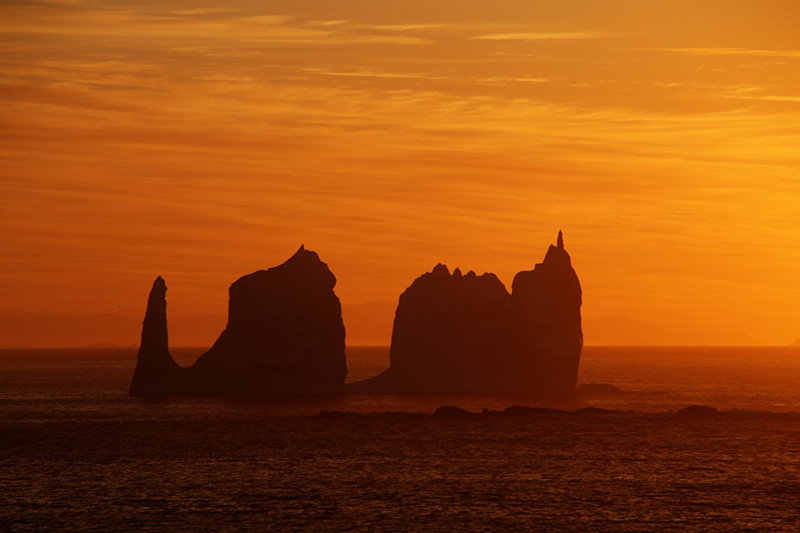
Photo Credit: Marissa Goerke
The sun sets on Palmer Station, silhouetting the pinnacles of a passing iceberg.
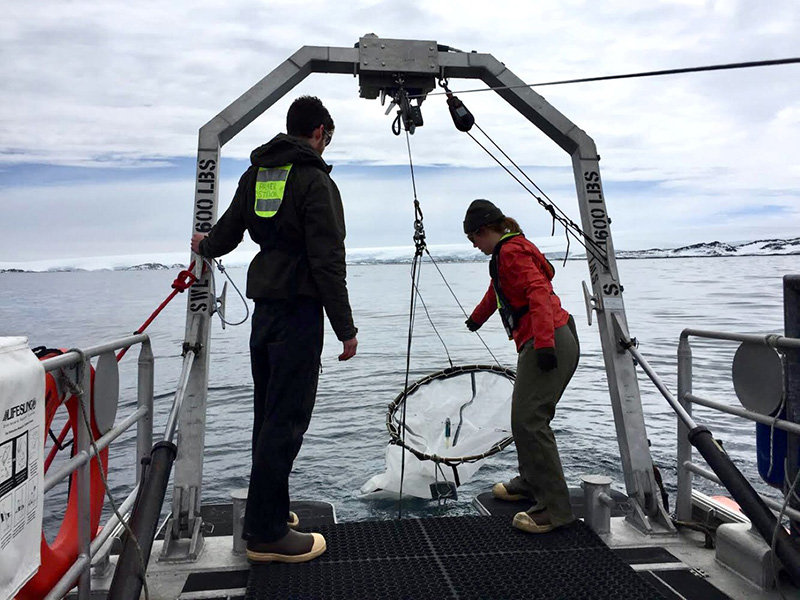
Photo Credit: Dr. Debbie Steinberg
Jack Conroy (left) and Leigh West, both researchers from Debbie Steinberg's lab, deploy a plankton net from the boat Rigil.
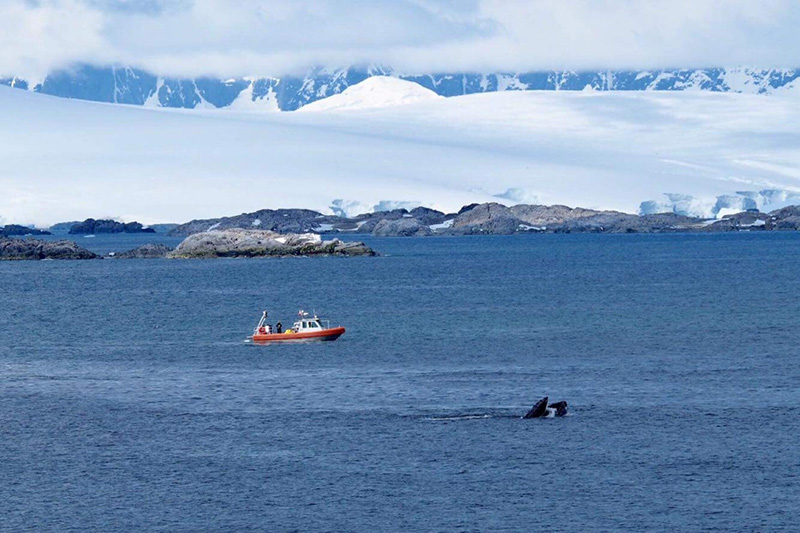
Photo Credit: Carly Quisenberry
Humpback whales feed near the boat Rigil as researchers conduct their fieldwork nearby
December’s summer solstice may have brought shorter days, but it certainly brought no less to fill them with. Mid-month, the research vessel Laurence M. Gould brought in a ship full of new Palmer researchers as well as personnel visiting station for the Palmer Long Term Ecological Research (LTER) project site review. Their port call was a jam-packed three days, wherein the reviewers visited the LTER field sites and saw lab work in action to evaluate the project’s performance and to formulate suggestions for moving the project forward. The bird researchers deployed their first penguin satellite tag during the site review, while the microbial, phytoplankton and zooplankton teams deployed a conductivity, temperature and depth rosette and towed a plankton net from the boat Rigil.
It was a good month for boating, with the Facilities Engineering, Maintenance, and Construction staff getting the floating dock back in the water at the beginning of December. This made loading Rigil considerably easier, which was much appreciated by the grad students and technicians who now use the boat four or five times a week for their various projects. Another exciting development was the installation and calibration of an echo sounder, called an EK-80. Multiple labs on station use this technology to find large aggregations of krill (“krill swarms”) within Palmer’s boating limits, and it has allowed for some exciting collaborations between LTER groups. Schuyler Nardelli, a doctoral student with Oscar Schofield’s lab, has been using the EK-80 weekly to examine krill and phytoplankton in penguin-foraging areas near station.
The marine technicians also quickly got new arrivals up to speed with regard to small-boat operation, teaching the two new grantees to pilot Zodiacs. J.D. Gantz and Leslie Potts will be on station for a couple of months studying the cold tolerance of insects like Belgica antarctica, a wingless midge that is the largest purely terrestrial animal on the continent. They ferried themselves from island to island, collecting specimens that have been exposed to a variety of environmental conditions.
This was also our first month of cruise ship tours, which is an exciting, if hectic, time on station. We kicked things off with a visit from the National Geographic Explorer, the first of twelve ships that plan to bring passengers ashore. These visits represent an opportunity for station residents to share the experience of living in this remote and special place with the public and for visitors to get a glimpse into science and daily life at Palmer Station.
The most enjoyable part of December for many was the holiday frivolity, with our main celebration being a white elephant gift exchange. Palmerites go all out for this annual swap, many contributing beautiful works of art and other handmade goods. As good-natured gift stealing is a time-honored part of the tradition, the evening can be as contentious as it is jovial, but nonetheless, it is always thoroughly enjoyed by all. On Christmas Eve, many from station gathered in the backyard to camp, enjoying each-others’ company on a rare two-day weekend.
Station News Home Page



















